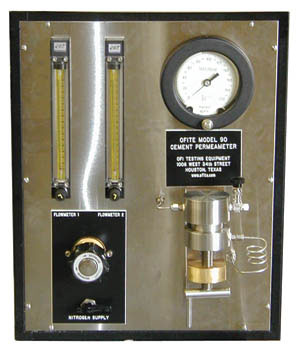Permeability Tester - OFITE
The OFITE Permeameter is utilized to measure the permeability of cement or core specimens one inch in diameter and one inch in length. The specimen is placed into a sleeve, which is then inserted into the "Modified Hassler" style test cell. Nitrogen at a constant flow rate is forced through the core and the differential pressure across the core is measured. The flowrate is measured with calibrated flowmeters. Viscosity is easily determined by the use of nitrogen property tables. These variables are incorporated into Darcy’s law to calculate cement sample permeability.

Method of Operation:
A specimen is placed into a core sleeve which is then inserted into the "Modified Hassler" style test cell. Nitrogen is displaced through the specimen at various flowrates to determine the permeability.
Features and Specifications:
- "Modified Hassler" cell accommodates 1" diameter cores
- Core length is one inch
- Instrumentation gauge displays driving pressure
- All Hassler components fabricated from 316 Stainless Steel
- Nitrogen utilized as test fluid
- Unit conforms to API Specification 10 guidelines
Size: 22" × 18" × 24" (56 × 46 × 61 cm)
Weight: 80 lb (36.3 kg)
Permeability is a measure of the ability of a fluid to flow through a porous media when subjected to a differential pressure and is mathematically equated by Darcy’s Law.
The primary function of a well cement is to isolate/seal the casing from the well bore. This seal prevents the migration of fluids into the annulus and upwards to the surface. Therefore, it is imperative that a well cement exhibit very low permeability.
The permeability of a petroleum reservoir is one of the most influential factors governing the production capabilities of a producing formation.
k = (2,000 × OP × Q × µ × L) / (A × (IP2 - OP2))
Where:
- Q = Flowrate
- k = Permeability
- A = Cross Sectional Area
- OP = Outlet Pressure
- IP = Inlet Pressure
- µ = Viscosity
- L = Length






















